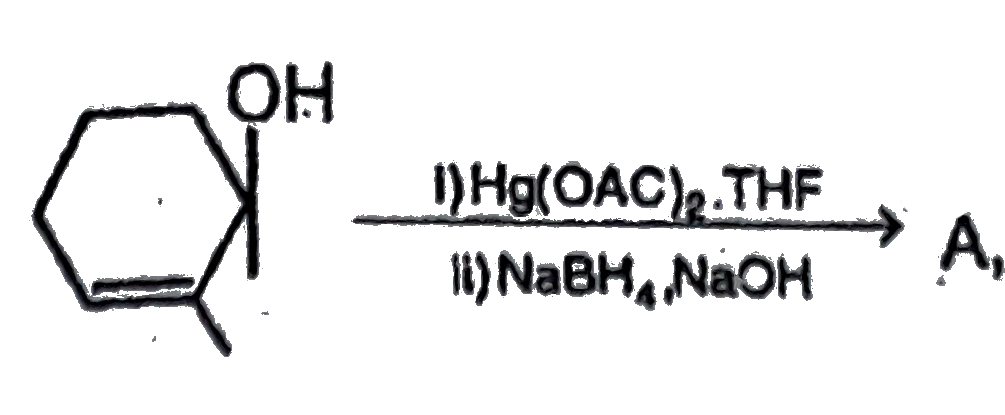Anti-Markownikoff's addition of HBr is not observed in
Pent-2-ene
Propane
But-2-ene
But-1-ene
The correct Answer is:3
To solve the question regarding the anti-Markovnikov addition of HBr, we need to analyze the conditions under which this type of addition occurs and identify which option does not fit these conditions.
1. Understand Anti-Markovnikov's Rule:
- Anti-Markovnikov's addition refers to the addition of HBr to alkenes in such a way that the hydrogen atom adds to the carbon with fewer hydrogen atoms (the less substituted carbon), while the bromine adds to the more substituted carbon. This is typically observed in unsymmetrical alkenes in the presence of peroxides.
2. Identify Symmetrical vs. Unsymmetrical Alkenes:
- Symmetrical alkenes have identical groups on either side of the double bond, meaning that there is no preferential site for the addition of HBr. In contrast, unsymmetrical alkenes have different groups attached to the carbons involved in the double bond, allowing for the application of Markovnikov's or Anti-Markovnikov's rule.
3. Analyze the Given Options:
- We need to look at the options provided in the question (not listed here) and determine which one represents a symmetrical alkene.
4. Conclusion:
- The symmetrical alkene will not exhibit anti-Markovnikov addition of HBr because there is no difference in substitution at the two carbons of the double bond. Thus, the addition will not favor one carbon over the other.
5. Final Answer:
- Based on the analysis, the answer is option C, which represents a symmetrical alkene where anti-Markovnikov's addition does not occur.
- Anti-Markovnikov's addition refers to the addition of HBr to alkenes in such a way that the hydrogen atom adds to the carbon with fewer hydrogen atoms (the less substituted carbon), while the bromine adds to the more substituted carbon. This is typically observed in unsymmetrical alkenes in the presence of peroxides.
- Symmetrical alkenes have identical groups on either side of the double bond, meaning that there is no preferential site for the addition of HBr. In contrast, unsymmetrical alkenes have different groups attached to the carbons involved in the double bond, allowing for the application of Markovnikov's or Anti-Markovnikov's rule.
- We need to look at the options provided in the question (not listed here) and determine which one represents a symmetrical alkene.
- The symmetrical alkene will not exhibit anti-Markovnikov addition of HBr because there is no difference in substitution at the two carbons of the double bond. Thus, the addition will not favor one carbon over the other.
- Based on the analysis, the answer is option C, which represents a symmetrical alkene where anti-Markovnikov's addition does not occur.
Topper's Solved these Questions
- HYDROCARBONSBOOK - AAKASH INSTITUTE ENGLISHCHAPTER - HYDROCARBONSEXERCISE - Assignment(Section - B) (Obejctive type question)
5 Videos
- HALOALKANES AND HALOARENES BOOK - AAKASH INSTITUTE ENGLISHCHAPTER - HALOALKANES AND HALOARENES EXERCISE - ASSIGNMENT SECTION -D
15 Videos
- HYDROGENBOOK - AAKASH INSTITUTE ENGLISHCHAPTER - HYDROGENEXERCISE - ASSIGNMENT (SECTION - D) (Assertion-Reason Type question)
15 Videos
Similar Questions
Knowledge Check
CH3−CH=CH−CH3HBr−−−−−−−−−−−−−−−−−−−−−−−→R2O2Δ(Anti-Markownikoff's addition)
Comment on optical activity of the products:ARacemicBDiastereomerCMesoDOptically pure enantiomer
Addition of mercuric acetate in the presence of water is called as oxymercuration.The adduct obtained gives alcohol on reduction with NaBH4 in alkaline medium.This is known as demercuration.Oxymercuration demercuration allows Markownikoff's addition of H, OH without rearrangement.The net result is the addition of H2O Answer the following question :

View SolutionAddition of mercuric acetate in the presence of water is called as oxymercuration.The adduct obtained gives alcohol on reduction with NaBH4 in alkaline medium.This is known as demercuration.Oxymercuration demercuration allows Markownikoff's addition of H, OH without rearrangement.The net result is the addition of H2O Answer the following question :

Product 'A'is :
View SolutionAddition of mercuric acetate in the presence of water is called as oxymercuration.The adduct obtained gives alcohol on reduction with NaBH4 in alkaline medium.This is known as demercuration.Oxymercuration demercuration allows Markownikoff's addition of H, OH without rearrangement.The net result is the addition of H2O Answer the following question :
CH3−CH3∣C∣CH3−CH=CH2(i)Hg(OAc)2.THF−−−−−−−−−−−−−−−−→(ii)CH3OHNaBH4NaOHAHI(Conc.)−−−−−−−→B
Product B is :
View SolutionWhat is Markownikoff's rule and how is it useful in predicting the addition of an unsymmetrical reagent to an unsymmetrical alkene? What is peroxide effect?
View SolutionThe reaction of HBr with
 gives
gives
View SolutionIn the presence of peroxide, hydrogen chloride and hydrogen iodide do not give anti-Markovnikov's addition to alkenes because:
View SolutionThe intermediate formed in the electrophilic addition of HBr to propene is a
View Solution
